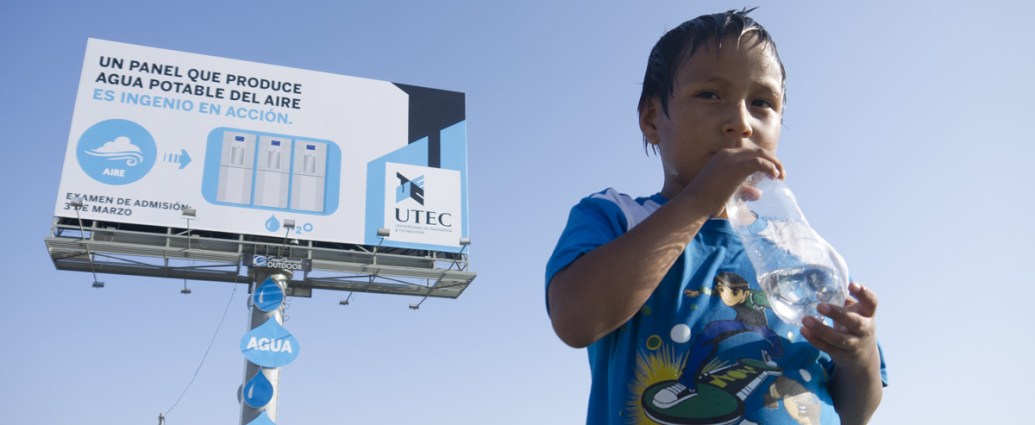In Lima, Peru, harvesting water from air became possible by repurposing an existing billboard.
In the heart of Lima, Peru, a stark paradox emerges. Despite being the second driest city globally, right after Cairo, Lima is nestled within Peru’s coastal desert, making the availability of clean drinking water a significant challenge.
A majority of its inhabitants are forced to depend on small wells, which unfortunately are often tainted and far from ideal. However, an intriguing fact is that the air hovering above Lima boasts a humidity level of 98 percent. This presents a unique opportunity to harness water from air.
Recognizing this potential, engineers from Lima’s University of Engineering and Technology (UTEC) bridged the gap between Lima’s arid conditions and the moisture-laden air above. Their solution? Transforming a commonplace billboard into a life-saving tool. Dubbed the UTEC Water Billboard, this structure is designed to extract water from the humid air.
How the Water Billboard Taps Water from Air

The process involves channeling the air through a series of reverse osmosis machines housed within the billboard. As the air journeys through a filter, its humidity is condensed, purified of carbon, and then stored. Residents can then easily access this clean drinking water by turning on a tap located at the base of the billboard.
What was once a mere advertising tool, often promoting luxury products out of reach for many locals, now generates an impressive average of 95 liters of clean water daily.

Want more examples of urban reuse? The Reprogramming the City book features 44 projects from 17 countries repurposing existing urban objects for new use.
In just its initial three months, the billboard astonishingly produced nearly 9,500 liters of fresh drinking water, catering to the essential needs of hundreds of local families. This innovative billboard has seamlessly woven itself into the fabric of local life. Every morning, farmhands and workers make a pitstop to refill their water bottles. Even schools have rerouted their sports and running classes, ensuring students can quench their thirst during their activities.
One grateful resident, while filling a container for his family, remarked, “They should replicate this in various locations. Ideally, in every village, every town. After all, it’s water that sustains us.”
The inception of the UTEC Water Billboard was a collaborative effort between UTEC and the ad agency Mayo DraftFCB. Their primary aim was to showcase the transformative power of engineering skills and to inspire the younger generation to envision a future in engineering. These billboards, the first of their kind globally, have set a precedent by converting air’s humidity into potable water. They stand as a testament to the innovative ways we can repurpose existing infrastructure, turning them into invaluable assets for communities, especially in a city thirsting for water from air.
Other Innovations Harnessing Water from Air
The concept of extracting water from air isn’t exclusive to Lima’s groundbreaking billboard. As the global demand for fresh water intensifies, scientists and innovators worldwide are exploring diverse methods to tap into the vast reservoir of atmospheric moisture. Here’s a look at some of the most promising innovations that are turning the dream of drawing water from air into a tangible reality.
- Atmospheric Water Generators (AWGs): These devices operate on the principle of cooling the air to its dew point. Once the air is cooled sufficiently, water vapor condenses into liquid form. AWGs range in size from small, household appliances to large industrial machines, ensuring that everyone, from individual users to entire communities, can benefit from water harvested directly from air.
- Hydrogel-based Harvesters: Researchers have developed hydrogels that can absorb moisture from the air during cooler, humid nights and release the collected water when exposed to sunlight. This technology is particularly effective in arid regions where temperature fluctuations between day and night are significant.
- Fog Harvesting: In regions with frequent fog, large mesh nets are erected to capture water droplets present in the fog. As the droplets accumulate, they combine and trickle down into collection containers. This simple yet effective method has been providing communities in arid coastal regions with a steady supply of water from air.
- Biomimicry and the Namib Desert Beetle: Inspired by the Namib Desert Beetle, which survives in one of the world’s driest climates by collecting dew on its back, scientists are developing materials and surfaces that can efficiently capture and channel water. This beetle’s unique ability to extract water from air in a desert environment offers invaluable insights into potential sustainable water harvesting techniques.
- Solar-powered Water Harvesters: Utilizing the power of the sun, these devices can extract water from air even in low-humidity environments. They employ a special material called a metal-organic framework (MOF) that captures and stores water molecules, which are then released and condensed using solar heat.
The quest for fresh water is one of the defining challenges of our time. As these innovations highlight, the atmosphere holds a promising solution. By continuing to invest in and refine technologies that can efficiently harvest water from air, we can inch closer to addressing global water scarcity and ensuring that every individual has access to this vital resource.

